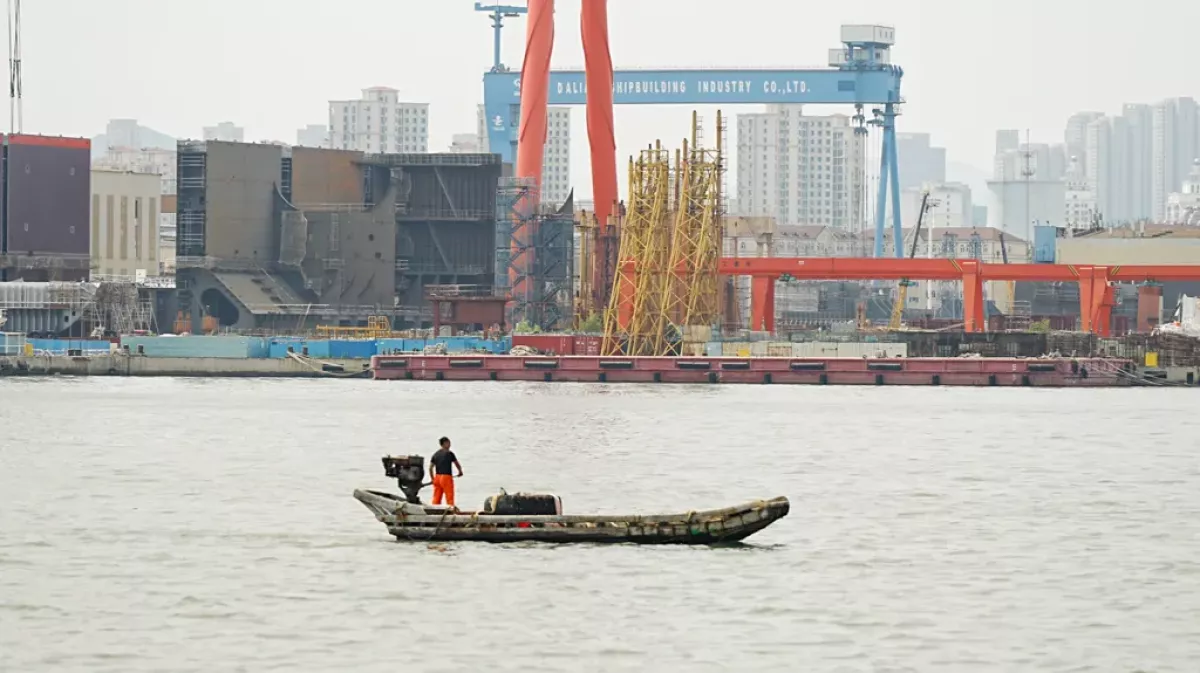China’s naval ambitions: Shipyards, strategy, growing challenge to US power
On a breezy afternoon in Suoyuwan Park in Dalian, pensioners belt out patriotic karaoke lines about the Communist Party guiding China toward “power and wealth.” Their chosen backdrop — a sprawling view of cranes and massive ships under construction — is symbolic. This northeastern port city is not only home to one of China’s largest shipyards but also a microcosm of Beijing’s growing naval ambition.
As the BBC writes in its analysis, what looks like harmless leisure to locals is viewed very differently in Washington. For US policymakers, Dalian represents a critical node in China’s rapidly expanding shipbuilding capacity—a development that could reshape global maritime power.
Building more, faster
China has emerged as the world’s shipbuilding powerhouse, capturing more than 60% of global orders this year.
“The scale is extraordinary… in many ways eye-watering,” notes Nick Childs of the International Institute for Strategic Studies. He estimates that Chinese shipbuilding capacity is roughly “200 times overall that of the United States.”
This dominance extends to military production. The People’s Liberation Army Navy (PLAN) is now the world’s largest by vessel count, fielding 234 warships compared with 219 for the US Navy. While Washington maintains superiority in tonnage, thanks to its larger aircraft carriers, the numerical edge increasingly lies with Beijing.
Between 2019 and 2023, China’s four biggest shipyards — Dalian, Guangzhou, Jiangnan, and Hudong-Zhonghua — produced 39 warships with a combined displacement of 550,000 tonnes, according to a study by the Center for Strategic and International Studies (CSIS). For comparison, the entire Royal Navy’s tonnage sits at around 399,000 tonnes.
“There’s no sign that the Chinese are slowing down,” says Alexander Palmer of CSIS. “The ability to produce and churn out warships has been extremely impressive and could make a strategic difference.”

Strengths and weaknesses
China’s naval rise, though striking, has limitations. It currently operates only two aircraft carriers and fewer submarines than the US Navy. Analysts stress that Chinese submarines are not as technologically advanced as their American counterparts and are primarily designed for the shallower South China Sea. Long-range operational capacity remains a hurdle.
Yet Beijing is investing heavily to close that gap. Satellite imagery from Hainan suggests major expansion of naval bases, including facilities to host Jin-class submarines capable of carrying nuclear missiles. Social media footage points to the development of unmanned underwater drones, potentially useful for surveillance and undersea warfare.
“The big question is how long will it take for the technology to mature,” says Matthew Funaiole of CSIS.
China’s shipbuilding boom is not purely military or commercial—it is both. The government promotes what it calls “military-civilian fusion,” ensuring that commercial shipyards can quickly switch to naval production if required. “
This is a politically motivated agenda to merge both the commercial and military entities together,” explains Funaiole.
That dual capacity could prove decisive in conflict.
“In any protracted conflict, if you have shipyards that quickly produce new ships, this is a huge strategic advantage,” he adds.
According to BBC, Beijing’s motivation is rooted in history as much as strategy. President Xi Jinping frequently invokes China’s “bitter memories of foreign assaults” during the Qing dynasty and subsequent turmoil. He has vowed the country will never again be humiliated, tying naval strength directly to national pride.
Strategic messaging
China is preparing to showcase its military achievements in an upcoming parade attended by Russia’s Vladimir Putin and North Korea’s Kim Jong Un. Analysts expect displays of anti-ship missiles, hypersonic weapons, and underwater drones. The message is aimed squarely at the West: China is no longer content to “hide its strength and bide its time.”
Still, Beijing insists its buildup is defensive.
“We have no interest in interfering in the business of other countries, especially militarily,” says Professor Hu Bo of Peking University.
But Taiwan remains the exception. While China denies any set deadline for “reunification,” it has not ruled out the use of force. US officials warn that an invasion attempt could come by 2027, a scenario Beijing dismisses but refuses to rule out.
Pushing boundaries
Despite reassurances, China’s navy is venturing further afield. Recent drills included circumnavigation of Australia’s coastline and carrier exercises near Japan. These moves, though legal under international law, have unsettled regional neighbors.
For Washington and its allies, the central question is straightforward: how far can China’s navy sail, and how quickly can it project power into the Indian Ocean and beyond?
“They still have a significant way to go, but they are certainly pushing the boundaries,” concludes Childs.
What began as patriotic karaoke in a park overlooking Dalian’s shipyards underscores a far bigger story: China’s transformation into the world’s leading shipbuilder, with a navy growing in size, sophistication, and ambition. For Beijing, this naval power is not merely about dominance at sea—it is about reclaiming historical pride, deterring foreign threats, and reshaping the global balance.
For the US, it poses a strategic challenge that will be difficult to counter, the article notes
By Sabina Mammadli








